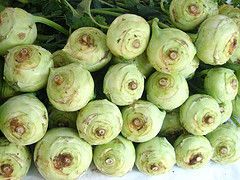Difference between revisions of "Kohlrabi"
(→Harvesting and Handling) |
|||
| Line 17: | Line 17: | ||
==Harvesting and Handling== | ==Harvesting and Handling== | ||
Kohlrabi is grown as an annual, with the enlarged stem being the most commonly used edible portion. The enlarged stem may have purple, white or green skin but the flesh is white. The leaves can also be eaten like collards. | Kohlrabi is grown as an annual, with the enlarged stem being the most commonly used edible portion. The enlarged stem may have purple, white or green skin but the flesh is white. The leaves can also be eaten like collards. | ||
| − | + | <br><br> | |
Only young kohlrabi should be harvested, since mature product becomes woody and tough. Leaf stems are a good indicator of quality; they should be succulent and tender. | Only young kohlrabi should be harvested, since mature product becomes woody and tough. Leaf stems are a good indicator of quality; they should be succulent and tender. | ||
| − | + | <br><br> | |
| − | Topped kohlrabi is usually packaged in film bags. Those with tops are usually bunched tied together like beets. | + | Topped kohlrabi is usually packaged in film bags. Those with tops are usually bunched tied together like beets. |
==Cooling and Storage== | ==Cooling and Storage== | ||
Revision as of 09:58, 27 March 2012
| Infobox on Kohlrabi | |
|---|---|
| Example of Kohlrabi |  |
| Freshness facts | |
| Optimum carrying temperature | 0°C to 1°C |
| Highest freezing point | - |
| Acceptable product temp. at loading into containers | Max. 2°C above carrying temperature |
| Optimum humidity | 95% to 100% |
| Ventilation setting for containers | 10 m³/hr |
| Storage life | 2 to 4 weeks (see text) |
| Climacteric / non-climacteric | Non-climacteric |
| Ethylene production | Very low |
| Ethylene sensitivity | Low |
| Modified / controlled atmosphere | - |
| Potential benefits | None |
| Availability | |
| On demand | |
Kohlrabi
Contents
Harvesting and Handling
Kohlrabi is grown as an annual, with the enlarged stem being the most commonly used edible portion. The enlarged stem may have purple, white or green skin but the flesh is white. The leaves can also be eaten like collards.
Only young kohlrabi should be harvested, since mature product becomes woody and tough. Leaf stems are a good indicator of quality; they should be succulent and tender.
Topped kohlrabi is usually packaged in film bags. Those with tops are usually bunched tied together like beets.
Cooling and Storage
Topped kohlrabi can be stored for 2 to 3 months at 0°C and 98% to 100% RH. Storage life is 2 to 4 weeks if tops are not removed. Storage-life can be improved with the uses of perforated film bags to maintain high RH around the product.
Kohlrabi are not chilling sensitive.
Controlled atmosphere considerations
There is no benefit from CA.
Storage disorders
Bacterial soft rot, Black rot.











